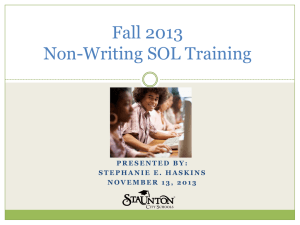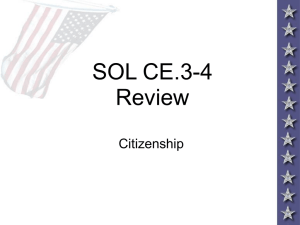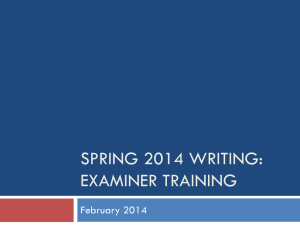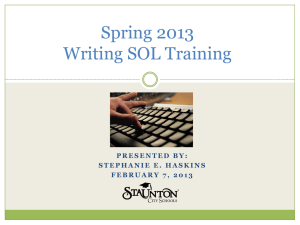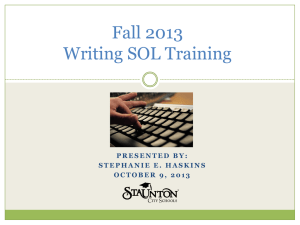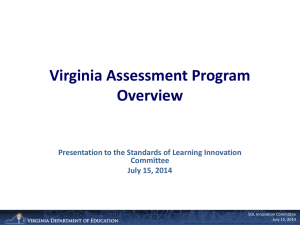Spring 2013 Writing SOL Training
advertisement
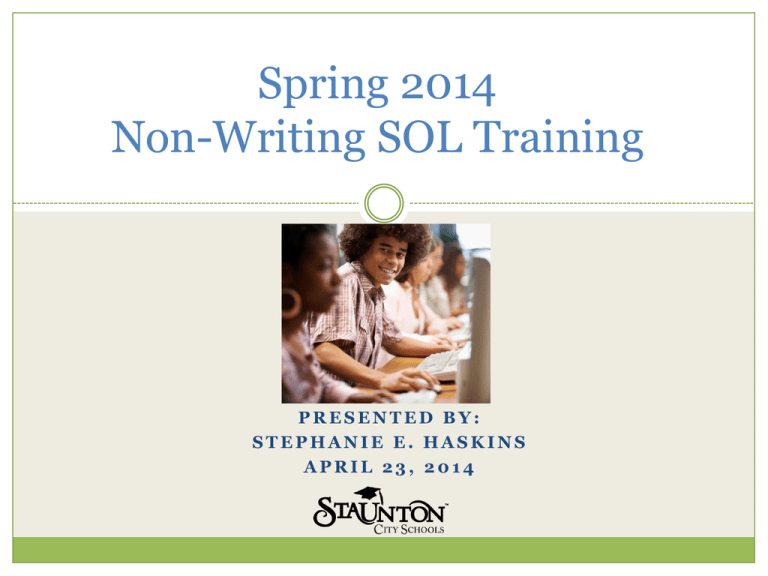
Spring 2014 Non-Writing SOL Training PRESENTED BY: STEPHANIE E. HASKINS APRIL 23, 2014 Training Agenda • Spring 2014 Non-Writing Timeline • Testing and Curriculum Resources • Test Security • Role of Examiners • Special Test Accommodations • Reminders for Testing Coordinators • Questions -2- Testing Timeline Date Event Week of April 12 Non-secure Testing Materials Arrive May 2 Data Upload File Due to DDOT Week of May 5 Term Grad Testing Week of May 12 May 16: Science 8 Week of May 19 May 19: Numeracy, US Hist II May 20: EOC Reading, Literacy, Civics, Math 4 (1), Science 3 May 21: VA & US Hist, WHII, US Hist I, Math 4 (2), Math 5 (1) May 22: VA & US Hist (T4), Reading 7, Math 5 (2), Math 3 (1) May 23: WHI, Reading 8, Math 3 (2), Science 5 Week of May 26 May 26: Make-ups May 27: AlgII, Geom(HS), Reading 6, History 3, VA Studies 4/5 May 28: AlgI (HS&MS), GeomH, Geom(MS), Math 8, Rdg 3 (1), Rdg 5 May 29: Biology, ChemistryH, Math 6, Rdg 3 (2), Rdg 4 May 30: Earth Science, Chemistry, Math 7 (**Term Grad only; NOT Expedited Retake) Week of June 2 Expedited Retakes (end-of-course) June 6 Last day to return materials Resources School Test Coordinator Handbook Student Data Upload File Requirements Test Implementation Manual Supplement to Test Implementation Manual Examiner’s Manual Pearson Access User’s Guide for the Virginia Assessment Program Virginia Standards of Learning Assessments Guidelines for Administering the Read-Aloud Accommodation Limited English Proficient Students: Guidelines for Participating in the Virginia Assessment Program Testing Upload Group Name: Consider how you want score reports to be organized. Group code: Will NOT appear on printed reports; allows for data sorts; Max 10 characters Test code: MUST double-check for high-school retesters. Ethnicity/ Race: Hispanic; 32 categories ELL information: Test tier, composite, literacy, SOA-LEP, AYP-D SOA Transfer: Enrolled after 20th day – Sept 19th or after Feb 24th** AYP: If a student began school ANY day AFTER the first day AND was NOT in our division last year, can be coded as AYP. May disregard reference to “September 30”. A: within division B: outside division/ within Virginia C: outside Virginia Term grad: Scheduled to graduate by Aug 31, 2014; Assigns equated forms first Project Graduation: High school only – Refer to definition in TIMS RP-Code: Genesis Retest: High school only – if retaking test Recovery: Reading or Math only – May only be coded Recovery 1 time per test – on FIRST test, following remediation D-Code: High school only – if pursuing modified standard diploma (needs literacy/ numeracy requirements) Online Test: Students NOT marked as online should have documented need Z-Code-A: Parent refusals (refer to additional information) Additions in RED and Deletions in RED Testing Upload Parent Refusals for Testing Refer to supporting documents. - What does it mean for the student? - What does it mean for the school? MUST involve principal conversation with parents, face-to-face meeting preferred. Include in session to mark test complete (5-refusal). Mark Z-Code-A in Student Upload. HB930: Eliminates following tests beginning 2014-2015: Grade 3 Science US History I Grade 3 History US History II Grade 5 Writing Form Matrices vs. 2Expedited Retake/Alternate vs. 3Third Attempt A maximum of three attempts are available during the fall and summer NonWriting test administrations. Students must receive remediation prior to being administered a third or fourth test attempt. Only Term Graduates and Project Graduation students should be tested using the Term Graduate forms. 1Main Testing Resources Test Implementation Manual: Page iii: What’s New? Page xii: Checklist of STC Responsibilities Page 9: Applications Available for Test Preparation Page 18: Test Manipulatives Page 30: Troubleshooting Appendix A: Test Security Appendix C: Special Testing Accommodations Appendix C: Documentation for Need for Paper/Pencil (page 89) Appendix D: Table of Testing Accommodations (page 94)* Appendix G: Online Tools Testing Resources Examiner’s Manual: What’s New? Applications for Test Preparation Be Familiar with Directions for Administering Test ** Online Tools, Icons, Descriptions Answering Student Questions Reporting Test Errors Trouble-shooting Online Testing Directions for Submitting Test security Special Test Accommodations Checklist of Examiner Responsibilities Testing Memos PearsonAccess™ Enhancements The Unlock User link has been added to the login screen. Unlock User allows a user to unlock their account and reset their password if they accidently locked it with three invalid login attempts. Note: The Unlock User link will not unlock accounts that were manually locked by another user; expired; or deleted. 12 PearsonAccess™ Enhancements 13 Table of Testing Accommodations Code Accommodation Student Content Area Description 1 10 26 Flexible Schedule SWD LEP Read-Aloud SWD LEP Calculator or Arithmetic Tables SWD H M R S H M M Testing with breaks requires the test to be completed within one school day; Multiple test sessions that involve testing over more than one school day—require a paper/pencil test. Tests are read (in English only) to the student. Must be recorded or proctored. Gr. 3 Mathematics—for use on the entire test. Gr. 4, 5, 6, 7 Mathematics—for use on the NONcalculator portion of the test. Grades 3-7 students must meet eligibility criteria. Grade 8 and EOC Mathematics—not applicable (see #28). S 14 Curriculum Resources ~ READING http://www.doe.virginia.gov/ http://www.doe.virginia.gov/testing/sol/standards_docs /english/index.shtml Standards, Curriculum Framework, Blueprint Sample Lesson Plans Vocabulary Resources Sample Text-Dependent Questions Using Statewide SOL Results to Guide Instruction Frequently Asked Questions Released Tests (NOTE: These do NOT align with 2010 standards. New 2010 tests will not be released until 2015.) http://www.doe.virginia.gov/testing/sol/practice_items/ Reading SOL Practice Items* Reading VMAST Practice Items Tabbed Reading Passage Demonstration (gr 8 & EOC) Reading Passage Scrolling Demonstration Narrated demonstration of TEI Items Sample Excerpts in Stand-Alone Items Sample Resources ~ READING Suggested Practice for SOL 10.4b, 10.5f, and 11.5d Students need additional practice drawing inferences using implied and explicit information in fiction and nonfiction texts. Before the Arctic surveyors could continue their work, they had to ensure the safety of the dogs and agree to the terms of exploring unknown, possibly dangerous areas of the tundra. Which feelings are conveyed in this excerpt? consideration optimism fright Source: Using Statewide SOL Results to Guide Instruction indifference caution Sample Resources ~ READING Source: Sample Excerpts in Stand-Alone Items Other READING Testing Updates: Reading Lexile Levels 1200 1090 1000 975 1015 980 900 870 850 800 800 745 700 600 600 500 400 200 0 Grade 3 Grade 4 Grade 5 Previous Standards Grade 6 Grade 7 NEW Standards NOTE: Updated correlations for grades 3-8 from VDOE. Grade 8 Other READING Testing Updates: Number of passages on reading SOL tests may vary due to length of passages. There will be at least five passages on an SOL test. Tests will continue to have 10 field test items, but some tests may have one passage with 10 items and other tests may have two passages with a total of 10 items split between them. About 15% TEI - technology-enhanced items. These will be more open-ended, and may not require a certain “number” of answers in a response. Example: Which words . . . ? vs. Which two words . . . ? One Section Review screen at the end of the test with all the reading passages and questions. NOTE: If TEI questions require a “stated” number of responses and all are not answered, will show as not answered. If TEI items do NOT state a specific number of responses, will show as answered. Tabbed presentation of paired reading passages in middle school and EOC. Grade 3 Reading: The grade 3 Reading test has TWO sections and is administered over TWO days. Be sure to STOP after Section 1! Other READING Instructional Reminders: Transition from “basic comprehension skills” to literary analysis – Use language from text to answer all questions; Examine the author’s style of writing and form reading-writing connections Teach nonfiction – very important, at ALL levels Pair fiction and non-fiction passages Teach roots and affixes – these will be tested as stand-alone AND related to a passage Study vocabulary Pull passages from content texts Ask reading comprehension questions Research (tested in grade 3 reading; tested in writing in all other grades). Curriculum Resources ~ MATHEMATICS http://www.doe.virginia.gov/ http://www.doe.virginia.gov/testing/sol/standards_docs /mathematics/index.shtml Standards, Curriculum Framework, Blueprint Sample Lesson Plans Instructional Videos Instructional Resources Technical Assistance on Selected SOL Vocabulary Word Wall Cards Vertical Articulation Using Statewide SOL Results to Guide Instruction Strategies for Minimizing Time & Improving Performance Released Tests (NOTE: New tests released in March 2014.) (Plain English sample to be released soon.) http://www.doe.virginia.gov/testing/sol/practice_items/i ndex.shtml#math Math SOL Practice Items Math VMAST Practice Items Narrated demonstration of TEI Items Mathematics Practice Tool Other MATHEMATICS Testing Updates . . . Grades 3-5 Mathematics: The grade 3-5 Mathematics test has TWO sections and is administered over TWO days. Be sure to STOP after Section 1! Make sure directions for TWO DAY TESTING are read. Grades 6-7 Mathematics: The grade 6 and 7 Mathematics test has TWO sections. Both sections must be administered on the SAME day. Formula Sheets: Make sure the correct formula sheet is provided to students. With the exception of retesters using 2001 standards, all other students should be using 2009 standards. Students taking an online Mathematics test ARE permitted to use a paper formula sheet in addition to the online version. Seal Code: Seal codes have been added as an option in Pearson Training Center. Other MATHEMATICS Instructional Reminders . . . Quantiles: All math results have related quantile score. Grid Paper: Intended for mathematical purposes (i.e. plot, etc.), NOT graphic organizers. Commas: Students must place commas in correct location within a number in order for answer to be correct. Mathematics content should support these process standards . . . Problem-solving Communication Reasoning Connections Representation Curriculum Resources ~ SCIENCE http://www.doe.virginia.gov/ http://www.doe.virginia.gov/testing/sol/standard s_docs/science/index.shtml Standards, Curriculum Framework, Blueprint Sample Lesson Plans Science Progression Instructional Resources Released Tests (NOTE: These do NOT align with 2010 standards.) http://www.doe.virginia.gov/testing/sol/practice_ items/index.shtml#science Science SOL Practice Items* Narrated demonstration of TEI Items Other SCIENCE Testing Updates . . . Chemistry: Students taking online Chemistry test MUST use Periodic Table located on the online test’s toolbar (NO paper copy). The table used may be accessed on the VDOE website. Instructional focus should include . . . THIS . . . NOT . . . Planning & conducting experiments Replicating procedure Applying to everyday experiences Performing skills in isolation Unifying themes Missing connections Developing habits of mind Giving information without questions Discovery of natural world Overemphasizing seatwork, terms, test prep Curriculum Resources ~ HISTORY http://www.doe.virginia.gov/ http://www.doe.virginia.gov/testing/sol/standard s_docs/mathematics/index.shtml Standards, Curriculum Framework, Blueprint Sample Lesson Plans SOL Institutes Instructional Resources Released Tests (NOTE: Tests from Spring 2012 ARE aligned with the 2008 standards. An additional “set of test items” will be released in March 2014.) Check out the Schedule for Review of NEW History and Social Science Standards of Learning . . . - Standards: January 2015 - Curriculum framework: July 2015 Other Testing Updates . . . TEI test types: Fill-in-the-blank, Histogram or Bar Graphing, Hot Spot, Number Line, Drag and Drop. Refer to Staunton City Schools website for description. Cut Scores have now been updated. Refer to Staunton City Schools website. Emphasis words such as most, main, and best will no longer be emphasized by italics or capital letters on any new SOL tests. The only exceptions will be the words NOT and EXCEPT, which will continue to be emphasized with capital letters on all SOL tests except for grade 3. The grade 3 tests will not contain test items with the words NOT and except. Continue to maintain focus on rigor of instruction and assessment. Refer to VDOE website. Computer Adaptive Testing (CAT) coming to middle school mathematics next year. More information and other CAT timelines will be coming. Online SOL Test: A Student’s Perspective TestNav Login Screen Online Tools Pointer Protractor Eliminate Choice Dot Highlighter Straightedge Pencil Compass Eraser Exhibit Notepad Calculator Ruler SOL Practice Items Pearson Training Center Test Security Agreement READ all of the Test Security Agreement prior to signing and administering any SOL assessment. Role of Examiners/ Proctors During test administration, Examiners/Proctors must monitor the testing process by moving as unobtrusively as possible about the room. They should ensure that students are working independently and do not have access to unauthorized materials. Monitoring the Testing Process 16 Things You Can Do While Actively Monitoring During Standardized Testing All you can do is . . . Walk around the room Watch students take a test Or is it? Other options? Answering Student Questions Examiners/ Proctors MAY answer questions regarding technical issues of the assessment. They may NOT answer questions that would provide any hint or clue with regard to the assessment. Examples of Technical Questions Scrolling: “To view all of the reading passage, use the scroll bar to the right of the passage to move the page up and down.” Navigating the test: “To move to the next question click Next”; “To go back to the previous question click Previous”; “To go back to a question from the review screen click on the question’s number”; “To submit your test click the Submit the test button”; “Go back to the test item to make sure the Pointer was used to indicate the answer.” NOTE: Examiners/ Proctors may NOT use the student’s mouse or keyboard to navigate any portion of the test for the student. FAQs When a student has completed testing can the test examiner scroll down the review screen (look over the student’s answer section on the answer document) and make sure the student has an answer for every question? No. The examiner must not touch the student’s mouse (avoid the appearance of providing assistance). The Examiner may only tell the student to “read the screen carefully” (online) or to “review the answer document carefully” (paper). FAQs We are concerned that our students might select the wrong button to submit their tests. Can the examiner submit the test for the student? No. The examiner must not touch the student’s mouse (avoid the appearance of providing assistance). Directions in the Examiner’s Manual state, when students are ready to submit their tests for scoring, they raise their hands. The Examiner gives permission to the student to submit and may say, “to submit your test click on the 3rd button which says Submit the test.” Guidance for Submitting a Test GRADES 6-8 & EOC: If examiner sees that student has unfinished items, examiner may only tell student to “Read the screen carefully.” 39 Guidance for Submitting a Test Grades 3-5: If examiner sees that student has unfinished items, the examiner may read this screen to the students. This screen says: “Stop. You are trying to exit the test. You have __ unfinished items.” (Refer to directions in Examiner’s Manual.) 40 FAQs If the student does not remember how to use one of the tools, can the examiner show the student how to operate the tool? No. The examiner may say, “for help with a tool, click on the help icon (life preserver) on the tool bar.” FAQs Can staff and students get practice with the various functions on a test before live testing? YES! Students and staff may practice the login process, using tools, navigation, and submitting tests by taking a Training Center Test or by using the practice TestNav items. Students who have the audio accommodation may practice the audio controls also by taking the Training Center Test in audio format. Look for Applications for Test Preparation in the TIM and Examiner’s Manuals for several other applications to help students. FAQs Can a student’s parent sit in the testing room with their child during testing? No, only test examiners/proctors and staff that are essential to testing (all of which have been trained and have signed the test security agreement) are permitted in the secure testing environment. FAQs Can a teacher review a new test to get a feel for the type of questions that are being asked? No, this is what released test items and practice items can be used for. Anticipated Released Tests Schedule for the “new” SOL History (2008 SOL) Spring 2013/ Item Sets Spring 2014 Mathematics (2009 SOL) Spring 2014 Reading (2010 SOL) Spring 2015 Science (2010 SOL) Spring 2015 FAQs While testing: Can I write notes of encouragement and put them on students’ desks, or can I verbally encourage students to do their best on the test, or pat them on the back to show support, etc.? No, none of this is permissible during the test session. These actions can give the appearance of inappropriate assistance and can result in an investigation and possible retesting. Paper vs. Online Students who meet one or more of following criteria may be assigned a paper/pencil test: Placement: Special situation school, homebound, Governor’s school Accommodation requires paper/pencil: large-print, Braille, flexible schedule (multiple testing sessions requiring more than one day) Documented medical condition: Exposure to computer will aggravate condition (i.e. seizure disorder, etc.) All other requests must be completed through “Documentation of Need for Paper/Pencil SOL Assessment” Interpreter Accommodation Interpreters . . . May have access to the SOL or VMAST tests for review purposes 24 hours prior to the administration, as authorized by the DDOT May interpret test directions, sample items, and questions regarding the mechanics of the tests. These questions should be directed to and answered by the test examiner. Must have test sessions proctored or video-taped. Must sign an Interpreter’s Affidavit. STC Reminders . . . Proctor Authorization Tickets and Student Authorization Tickets – These tickets should be printed no more than 4 days prior to the test window start date and must be stored in a secure location until needed. Start the test session the day of the scheduled session. Use the Examiner’s/ Proctor’s Test Booklet/ Test Ticket Transmittal Form/ Affidavit to distribute and collect test tickets and materials to examiners. Provide Examiners extra copies of the formula sheets and the Periodic Table of the Elements, where applicable. Ensure that all examiners/ proctors have allowable test manipulatives. (Refer to instructions in TIM and Examiner Manual for clearing calculator memory.) More Reminders . . . Section Breaks– Some tests have two sections, and a seal code must be used for the next section. Grade 3 Reading (2 Days) Grades 4 – 5 Mathematics (2 Days): - Section 1 – NON-calculator - Section 2 – 4-function calculator Grades 6 – 7 Mathematics (1 Day): - Section 1 – NON-calculator - Section 2 – Scientific calculator More reminders . . . View the status of each test session through Session Details screen (Ready, Active, Exited, Resumed, ResumedUpload, Submitted, Processing, Completed, Marked Complete). Add, move, and remove students from test sessions, as needed. Students who are absent on the day of testing must be removed/moved from the session before it can be stopped. Stop all online test sessions at the end of the day. All students must show a Completed status on the Session Details screen. Any students with a Not Started, Exited, or Resume status must be removed/ moved to a make-up or irregularity session before stopping the test session. More reminders . . . Moving a student: If students are moved to an alternate testing site to complete their tests, their Student Authorization tickets must be collected by the Examiner or Proctor prior to the move and redistributed only after the students are settled in the new location. While in transit, students must not be allowed to discuss the test with anyone or have access to educational materials. Their online test must be Exited prior to being moved to the new location. Before the student can log in (using the same information on the test ticket) to complete their test, the student’s test must be Resumed in Test Session Management. Testing Irregularities Report any irregularities within 24 hours. MOST Common Irregularities: #1 - Student unable to complete test #2 - Accommodation not provided or inappropriate accommodation provided #3 - Test inappropriately marked complete #4 – Wrong test #5 - Inappropriate manipulative Marking Tests Complete Mark test complete guidelines: Every student identified for testing must be accounted for via an online test or a paper document, including students who were not tested because they: Were exempt due to LEP Were absent during the entire testing window Refused or were disruptive Cheated Were involved in a medical emergency Failed the course but passed the test and are retaking the course Took a substitute test for verified credit Move these students to a new session and the DDOT will mark these tests complete at the conclusion of testing. Other reminders . . . Testing Accommodations: Add Test-Specific data in PearsonAccess to indicate what accommodations were provided to the student under the Test Details screen of PearsonAccess. (Temporary Accommodations may be handled through the upload or under Student Registration.) Student Alerts: Clear all student alerts for the school, when possible. Ask if there are questions related to alerts. Be sure that the RETEST flag is selected on the Test Assignment screen for every student who is retaking the test for verified credit. High School Only: Substitute Tests: If a student is enrolled for the first time in a course that requires an EOC test and has taken or will take an approved substitute test in place of the EOC tests, include in upload and select Testing Status code 10. If a student has failed an EOC test and takes an approved substitute test as a retest in an attempt to earn a verified credit, complete Testing Status code 10 AND set Retest flag to Y. Read-aloud/Audio for Reading: Under certain circumstances an LEP student or a student with a disability may receive the read-aloud or the audio accommodation on the EOC Reading test even though the student has not been determined as eligible based on criteria for read-aloud tests Questions?


